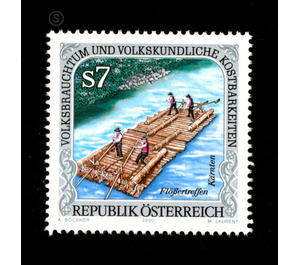folklore - Austria / II. Republic of Austria 2000 - 7 Shilling
Theme: Art & Culture
| Country | Austria / II. Republic of Austria |
| Issue Date | 2000 |
| Face Value | 7.00 |
| Printing Type | combination printing |
| Stamp Type | Commemorative |
| Item Type | Stamp |
| Chronological Issue Number | 1668 |
| Chronological Chapter | OOS-OE2 |
| SID | 62016 |
| In 64 Wishlists | |
Among all the rivers of the former Inner Austria (Styria, Carinthia and parts of today's Slovenia) the Drau has without doubt the oldest shipping tradition. One can associate the beginnings of rafting with those of the timber trade. The earliest documented proof of freight traffic on the Drau dates back to 1209. Drauflößerei usually started at Easter and lasted until November. The rafts were assembled on natural tributaries of the Drava River. The first step was the construction of the raft floor, which consisted of three or four panels. In a panel 10 to 15 equal length round logs were integrated with a length of about 4.30 meters. In the middle of the panels, one trunk each extends from one panel to the next, thus preventing a lateral displacement of the individual parts of the raft relative to one another. The steering was made via the front and rear mounted rudders. The forward helmsman made the changes of direction, the rear helmsman had to just make the raft straight. This required a lot of skill, concentration and, above all, the most accurate knowledge of the course of the Drava and its pitfalls. Rafting in the upper Drau valley has a long tradition. In the year 2000, the International Rafter Meetings, which will also be attended by rafters from several European countries, will take place for the twelfth time.


